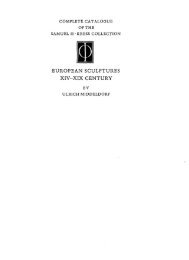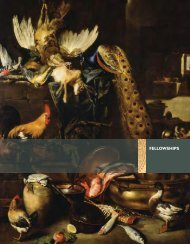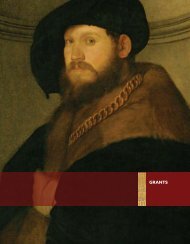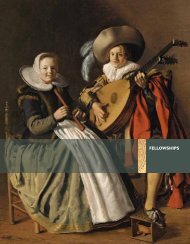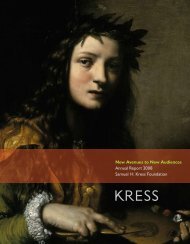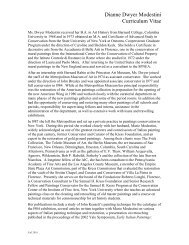The Campus Art Museum - Samuel H. Kress Foundation
The Campus Art Museum - Samuel H. Kress Foundation
The Campus Art Museum - Samuel H. Kress Foundation
Create successful ePaper yourself
Turn your PDF publications into a flip-book with our unique Google optimized e-Paper software.
<strong>The</strong> respondent situated this struggle historically:<br />
<strong>The</strong>re was still a battle in Chicago. <strong>The</strong> <strong>Art</strong> Institute for a long time did not<br />
show an interest in contemporary art and many of the collectors who were<br />
interested wound up banding together to form the <strong>Museum</strong> of Contemporary<br />
<strong>Art</strong>. It’s now just gone past its 40th birthday so it was founded barely just<br />
before this museum was open. A lot of those people said, “well we can see we<br />
aren’t making any headway with the <strong>Art</strong> Institute,” so there was this sense of<br />
struggle.<br />
Much of the southern European art from the Medieval and Renaissance<br />
periods is religious in nature. A few noted that this could be “tricky” in terms of using<br />
the works for educational purposes, but in general, professors, curators, and docents<br />
employed the works in ways that explored their historical and socio-political contexts.<br />
That is, most of the people with whom I talked tended to see the works as important<br />
in non-religious ways, as portrayed by a University of Arizona student:<br />
When I first came to this art museum, I was really little, and I went to the<br />
Retablo and I hadn’t realize it was religious or anything, I just thought “wow,<br />
this great story was preserved and passed through the ages,” and, yeah, I was<br />
really impressed by that.<br />
I began to note, therefore, when people found the religious nature of the works<br />
meaningful in itself. Several curators talked about how the paintings allowed them<br />
to make strong connections with religious studies programs. <strong>The</strong> MU <strong>Museum</strong> of<br />
<strong>Art</strong> and Archaeology projects slides of the religious works at Christmas time while<br />
students from the school of music perform Handel’s Messiah. Several interviewees<br />
revealed more personal connections. A professor in Arizona told about being asked<br />
by her grandson to be his confirmation sponsor:<br />
I said, “I know where we can come and look to talk about some of this,” because<br />
he was supposed to be studying scripture and things and he’s busy doing soccer<br />
and basketball and every other thing…. And so, we came and looked at some of<br />
these church pieces [in the <strong>Kress</strong> Gallery].<br />
A couple students described being moved spiritually. <strong>The</strong>y each felt captured<br />
by a particular object as this student described:<br />
When I came here in 8th grade, I had a very religious experience in front of<br />
one of the pieces and decided that I was going to be a nun which obviously<br />
didn’t come about, but it just blew me away. It was the crucifix that’s on the<br />
far north wall. And it hung, well, I was shorter then, but it was above me and<br />
the lighting coming down on it, you could see the piece really clearly and all of<br />
the details on it and even the parts that looked really weathered or damaged<br />
looked like they were supposed to be that way, I mean just like human bodies<br />
sustain that kind of damage just existing, and then the shadow behind it.<br />
Challenges and Possibilities<br />
19



